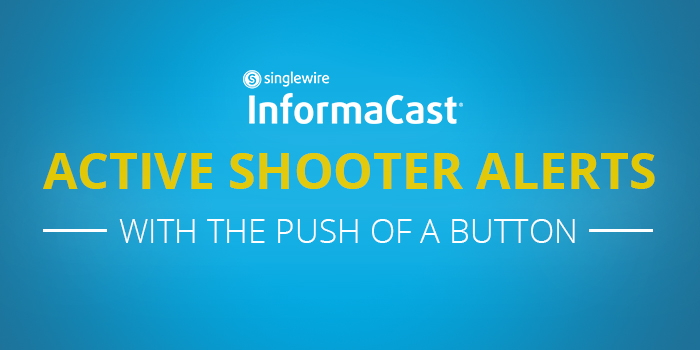An active shooter situation is one of the worst emergencies any organization can face. It is a challenging situation to plan for and can be even more difficult to respond to. One of the biggest challenges is sharing information about what is happening with people within your organization. If an active shooter enters one floor or end of a building, how do you let people in other areas know to seek safety and alert authorities?
A mass notification system can help, but different solutions offer different alerting methods, and some may not be as quick or effective as others. InformaCast from Singlewire Software has unique features ideally suited for triggering alerts about active shooter situations.
Simple Active Shooter Alerts
In this blog post, we’ll outline why InformaCast offers one of the quickest and easiest ways to alert an entire organization about an active shooter event. Watch the video below to see how it works, and read on for more details.
The Problem with Mobile Alerts
Much of the mass notification space today is focused on mobile-only alerting methods. This usually requires triggering a message from a mobile app or web interface. On the surface, this makes sense. People are rarely without their phones, so simply sending mass SMS-text messages should be enough to alert people about an active shooter situation. However, there are several issues with relying on this as a primary means for warning people about an active shooter.
First, while it’s true that many people keep their cell phones near them, there could be several obstacles to ensuring they see an alert in a timely manner. In classroom or business settings, phones may be stored away during classes or meetings. Cell phones may also be on silent, which means there is no prompt for the recipient to check their phone for an alert. If you’re only relying on a text message to deliver an alert, you’re missing an opportunity to leverage intrusive audio that grabs people’s attention can interrupt other ongoing events.
There’s also an issue with sending the initial alert out. Most active shooter training, such as ALICE and Run. Hide. Fight. from the Department of Homeland Security focus on individuals deciding for themselves the best action to take. These pieces of training also emphasize that a person’s first option should always be to get away from an active shooter if possible. But if you see or hear an active shooter, you may feel a sense of obligation to the other people in your organization to alert them that they may be in danger. With a mobile-only mass notification system, this can waste precious seconds. You may need to unlock your phone and find the right message to send, or log into a web interface and again find the right message before you can alert people. In an active shooter situation, this is less than ideal, as you want to be able to share information as quickly as possible, then remove yourself from the area to get to safety.
So what’s the other option?
Push Button Alerting
InformaCast offers a quick and easy way for a person to alert their entire organization and then get themselves to safety. By configuring a panic button on IP phones, a person only needs to press the button and leave. They don’t need to worry about logging into anything or finding the right app to launch a message, because the message is prebuilt and available on the phone.
Many organizations already have IP phones throughout their buildings, whether it’s in a classroom, a nurse station, or at a desk in an office. Connecting that phone to InformaCast allows you to configure panic buttons on the phone. That panic button can then have audio and text messages applied to it, so when the button is pressed, it broadcasts audio to other desk phones, as well as IP speakers, overhead paging systems and desktop computers. Text can be displayed on desktop computers, digital signage, mobile phones and other applications like Microsoft Teams and Cisco Webex Teams. This adds value to investments in existing technology by utilizing them for safety purposes while giving people in your organization a quick and easy way to deliver attention-grabbing alerts to others about an active shooter.
